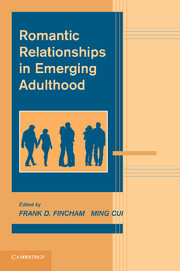Book contents
- Frontmatter
- Contents
- List of Contributors
- Foreword
- PART I INTRODUCTION
- PART II CONCEPTUAL AND METHODOLOGICAL FOUNDATIONS
- PART III THE DEVELOPMENTAL CONTEXT OF ROMANTIC RELATIONSHIPS IN EMERGING ADULTHOOD
- PART IV RELATIONSHIP PROCESSES IN EMERGING ADULTHOOD
- 9 The Evolution of Romantic Relationships: Adaptive Challenges and Relationship Cognition in Emerging Adulthood
- 10 Initiating and Evaluating Close Relationships: A Task Central to Emerging Adults
- 11 Putting the Romance Back Into Sex: Sexuality in Romantic Relationships
- 12 Understanding Romantic Relationships Among Emerging Adults: The Significant Roles of Cohabitation and Ambiguity
- 13 Implications of Parasympathetic Nervous System Functioning for Affect Regulation and Romantic Relationships in Emerging Adulthood
- PART V PRACTICAL IMPLICATIONS
- Index
- References
12 - Understanding Romantic Relationships Among Emerging Adults: The Significant Roles of Cohabitation and Ambiguity
Published online by Cambridge University Press: 06 December 2010
- Frontmatter
- Contents
- List of Contributors
- Foreword
- PART I INTRODUCTION
- PART II CONCEPTUAL AND METHODOLOGICAL FOUNDATIONS
- PART III THE DEVELOPMENTAL CONTEXT OF ROMANTIC RELATIONSHIPS IN EMERGING ADULTHOOD
- PART IV RELATIONSHIP PROCESSES IN EMERGING ADULTHOOD
- 9 The Evolution of Romantic Relationships: Adaptive Challenges and Relationship Cognition in Emerging Adulthood
- 10 Initiating and Evaluating Close Relationships: A Task Central to Emerging Adults
- 11 Putting the Romance Back Into Sex: Sexuality in Romantic Relationships
- 12 Understanding Romantic Relationships Among Emerging Adults: The Significant Roles of Cohabitation and Ambiguity
- 13 Implications of Parasympathetic Nervous System Functioning for Affect Regulation and Romantic Relationships in Emerging Adulthood
- PART V PRACTICAL IMPLICATIONS
- Index
- References
Summary
Cohabitation has become a common element of the path that emerging adults travel as they navigate romantic relationships before settling down into marriage. There has been an explosion in the practice of cohabiting before marriage, and many emerging adults now cohabit regardless of marriage intentions. Along with the wide availability of birth control and the increased likelihood of nonmarital sex, cohabiting reflects fundamental changes in how men and women date and mate. This chapter describes this growing trend, including how individuals during the period of emerging adulthood view cohabitation and how they can be affected by it as they pursue their romantic relationship and family goals.
LIVING TOGETHER OUTSIDE OF MARRIAGE: A NEW NATIONAL TREND
Many changes have occurred in family demography in the United States over the past several decades. One of the most significant changes is an increase in the number of couples who live together without being married. The U.S. Census now inquires about romantic partners sharing a household, and the last report indicated that unmarried couples were living together in 4% to 6% of U.S. households. This upward trend in cohabitation is likely linked with many other changes in recent decades, including the diminishing number of U.S. households that involve married couples and, most significantly for the focus of this book, the trend toward delaying marriage until the late 20s.
- Type
- Chapter
- Information
- Romantic Relationships in Emerging Adulthood , pp. 234 - 251Publisher: Cambridge University PressPrint publication year: 2010
References
- 7
- Cited by

